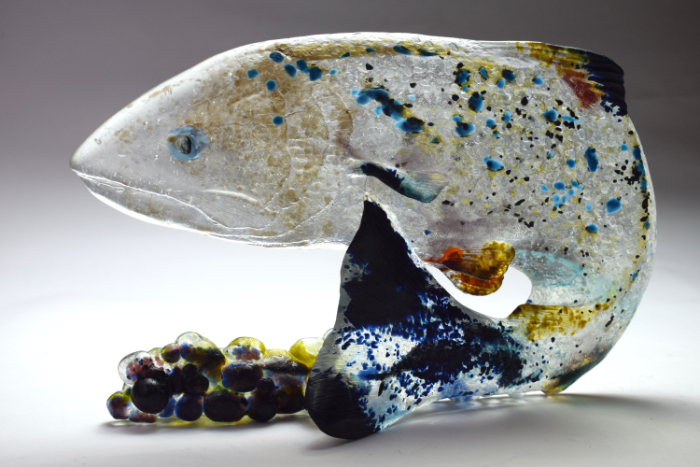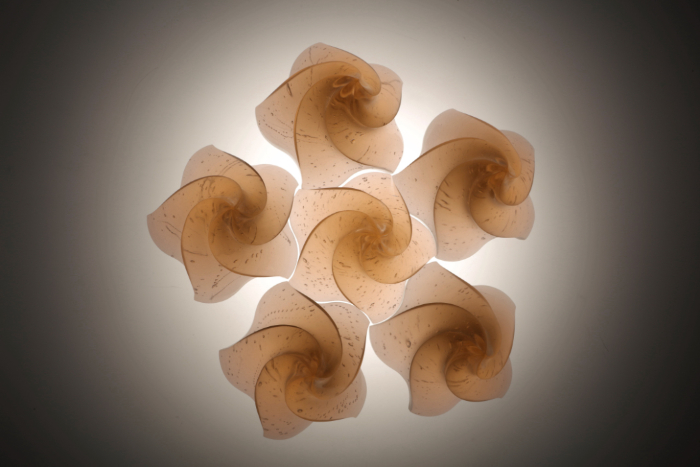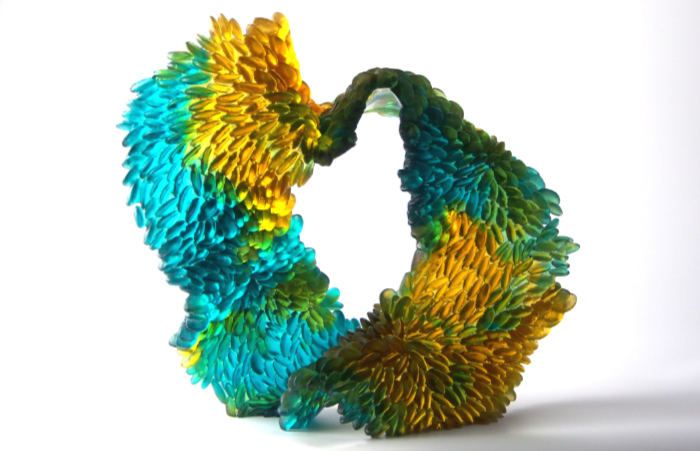
A Twist in Time
Nina Casson McGarva loves to manipulate her cast glass pieces straight out of the kiln to get a spontaneous effect. Linda Banks finds out more about this hard working contemporary glass artist.
You come from a family of makers. What led you to start working with glass?
My family on my mother’s side are all makers. Mick and Sheila Casson were potters In the beginning of studio pottery in England; my uncle Ben Casson, who is a cabinet maker, works with his partner Lynn Hogson, and my aunt, Lucy Casson, is a London-based artist who makes sculptures out of found objects and metal. My mum, Clare (Casson) McGarva, always worked with textiles, but also helps in my dad, Andrew McGarva’s pottery.
I’ve had a lot of opportunity to work with clay, textiles, wood and metal. I was lucky to grow up knowing and believing I could be a maker for a living, like all of them. I also have a sister who is an archaeologist who has learnt to be a willow weaver over the past few years.
I started glass blowing at 17 after two years of training to be a cabinet maker. I visited the school, tried it out for a day. I knew it was something I couldn’t learn at home, and it would widen my knowledge of materials, so I gave it a go.
I was driven by a hot, moving material; that was so fascinating and challenging. I think that’s what got me hooked and, 15 years later, the same attraction to the challenge of the material remains.
I’m a very technically-driven artist, as I grew up learning skills. My start with glass was in a French vocational school. I trained to be a crystal factory worker for four years, which gave me good basic technical knowledge of hot blown glass.
When I went to art school on the Danish island of Bornholm I discovered there was so much more that could be done with glass. I finally found my way to something which fits my personality and that happened when I had the opportunity to experiment and be creative with glass and my knowledge of techniques.
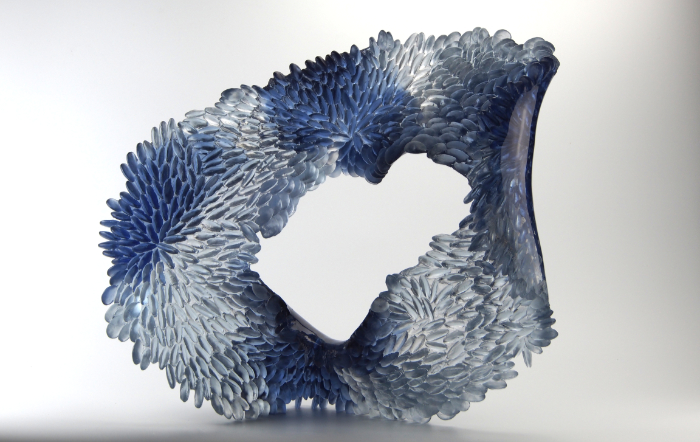
What glass techniques have you used, and which do you prefer?
I started with glass blowing, which I did for the first 10 years of my glass journey. Then I was shown all the kiln techniques at art school, like hanging glass in the kiln, fusing, slumping, pate de verre, sand casting, kiln casting, hot mould blowing and mixing things up, like using blown pieces in the kiln or using kiln casting in the blowing studio, which was my way into working like I do now.
I like working with hot glass techniques, but I prefer the aesthetics of kiln-cast glass best. My work is a bit of both, which is ideal for me.
The technique I use mostly now is kiln-cast glass. I start by making a mould of the model. I make all my models in wax first. I pour a plaster/silica mould on the wax and steam the wax out once the mould has set. Then I cast the glass in my mould in a kiln, which takes about a week of firing. I break the mould off the glass once it is out of the kiln and then the cleaning and grinding begins, prior to the second firing. I lay my cast glass in the kiln, get it up to a malleable temperature and manipulate it straight out of the hot kiln with big fireproof gloves to give the final shape to the glass sculpture. This part takes a few minutes and must be just the right timing to avoid shattering the piece from thermal shock. Then I put it back in the kiln for annealing and cooling slowly to room temperature. I clean it and engrave a texture pattern to finish the sculpture. The process for one big piece takes a month, sometimes more, as it doesn’t always work smoothly.

What is your creative approach? Do you draw your ideas out or dive straight in with the materials?
I never draw my work beforehand. I’m very much a builder and I think in 3D more than 2D. I build up my patterns in wax with repetition and the instinct of the moment. The way I put my texture patterns together must come spontaneously. I feel more creative if there isn’t a precise plan. The creative process happens when I’m making.

Then, when I get the hot cast glass out of the kiln to shape it, again it’s mostly done by instinct. I know that, if I did have a plan, I would be disappointed, because it is never exactly as I imagined. I also like the surprise of what it has turned into when I get it out of the annealer; it keeps it exciting. If I have too many guidelines, as with a commission, it never turns out very exciting at the end.
What inspires your work?
The nature I see around me. I’m very much a countryside person. I grew up playing in the fields and woods with no neighbours, and now always seek that in the places I live as an adult. I am inspired by the changes and patterns in the life cycles of plants.

What is your favourite tool or piece of equipment and why?
My fireproof gloves, because I can manipulate hot glass without it being at the end of a pipe, which is necessary when one blows glass.
Where do you show and sell your work?
The first gallery that gave me a chance was Vessel Gallery in 2019. The following year, I started showing at Peter Layton’s London Glassblowing Gallery and at Gallery 10 in Edinburgh. Then I was invited to show with Habatat Michigan and then Habatat Florida.
Currently, I’m working on pieces to send to Red Moon Gallery in Melbourne, Australia. Despite the pandemic and everything else, I’ve had a big demand for work, which I’m grateful for. I had to turn down some galleries this year because I’m at full making capacity.

What advice would you give to someone starting out on a career in glass?
Make glass in the way which suits your personality. Once you have a few years of basic knowledge in the techniques you like, you can play around and experiment. Don’t be afraid to take risks. Also travel – go and see how they make glass art in other countries. Work for a few different artists before you set up your own studio to give you an idea of the way you would like to work yourself.
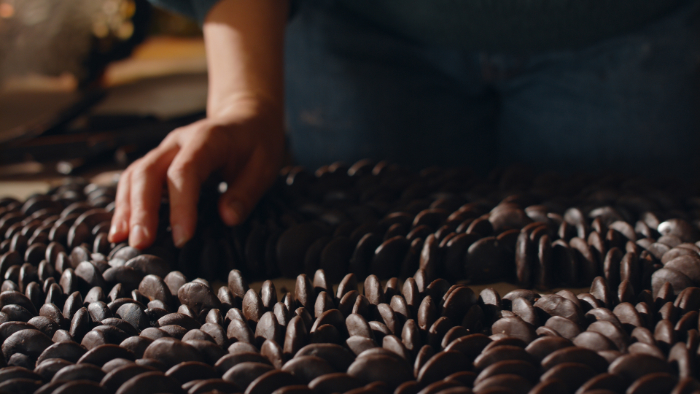
How did you feel when you won the Arts and Crafts award at the 2022 British Glass Biennale?
Oh it was a big honour! There was so much amazing work in this year’s biennale, so I’m very flattered that they chose my piece. It’s my first award and if feels great to be recognised for the work I put into my glass art. It has not been easy; it is more than a full time job, which I do alone.
Where is your glass practice heading next?
I just found a new work space to rent in Stroud, which is closer to home, so I will have to work on making it a functional space. I have a lot of new design ideas to make models for, so I may explore those while I set up my new space.
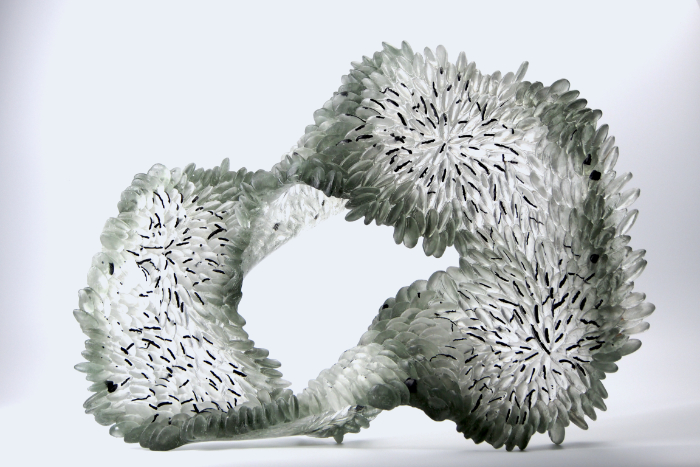
Is the global energy crisis affecting your practice?
It definitely is – especially because I just found a bigger workshop and I want to have several kilns to be more productive. Glass casting takes several days of firing in a kiln, and the bill for my electricity is going to be really high.
I’ll keep going and find ways to afford the electricity bills. It’s better to take the risk than abandoning the idea of upscaling the studio. It’s just one more obstacle to overcome in the series of challenges I’ve faced since I moved to England five years ago.
About the artist

Born in Gloucester, England, Nina Casson McGarva grew up in rural central France in the Burgundy countryside.
She learned the technical skills of glass blowing at the National French Glass school in Yzeure, then expanded her methods at The Royal Danish Academy of Fine Arts on Bornholm.
After residencies in the US and Japan, she settled in the English countryside in her studio at Wobage craft farm in south Herefordshire.
Nina has shown her work in exhibitions in Europe, the US and Japan.
Find out more on her website: https://www.ninacassonmcgarvaglass.com/
Main image: ‘Kelp Swirl’. Photo by the artist.
